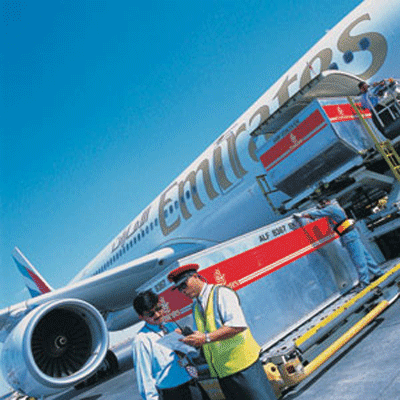Bankers Handicap
Air Cargo 2008
 The
airfreight market will continue to be one of the global growth sectors
over the next few years, according to a study released December 12, by
analysts at Hamburg, Germany-based HSH Nordbank AG. The
airfreight market will continue to be one of the global growth sectors
over the next few years, according to a study released December 12, by
analysts at Hamburg, Germany-based HSH Nordbank AG.
The following is an edited version of the
bank’s study.
According to HSH Nordbank, long-term global
air cargo trade growth should be around 7% per annum in the next several
years.
Asia Strongest Growth
At present, nearly 40% of global trade in
terms of the value of goods is transported via airfreight. The strongest
growth in revenue-ton kilometers (RTK) is recorded on intercontinental
routes, particularly between Asia/Pacific and Europe or North America.
“As a consequence of further production
relocations and above-average growth prospects for the region, it is expected
that by the year 2025 almost 63% of all exports and imports will originate
in, or be destined for, Asia/Pacific”, said Claudia Erdmann, a Nordbank
analyst.
In particular, the growth of the Chinese
airfreight market is the driver of the entire Asian region, the report
said. China’s domestic market will also be able to report growth
rates averaging 11% p.a. over the next 20 years, driven by the pick-up
in domestic demand.
Freight Rates Still Pressurized
The downtrend in freight rates has decelerated
in past. The slump in rates of the past few years has been halted particularly
thanks to the implementation of ancillary cost surcharges for security
and fuel. Furthermore, the proportion of special-type and thus higher-priced
airfreight is rising, Nordbank said.
FedEx The Largest Airfreight Carrier
With 15.145 billion, FedEx is the world's
largest airfreight carrier in terms of RTK. With the establishment of
a central hub in Guangzhou, FedEx gained a foothold in the fastest-growing
export market at an early stage, thus securing its leading position over
the long term. Air France-KLM follow with a total of 10.571 billion RTK.
With the equity holding in Jade Cargo International, the first Chinese
freight airline with foreign participation, Lufthansa Cargo attempts to
enhance its positioning on the Asian market, the report said.
Rising Demand For Mega-Carriers
Based on estimates by the two leading aircraft
manufacturers, Airbus and Boeing, approx. 4,000 freight aircraft will
be in use by 2025 respectively. While the segment of small carriers is
forecast to decline from the current level of 42% to 36% by 2026, the
proportion of medium-sized and mega-carriers is set to increase to about
31, respectively 33% percent.
Of the 1,980 aircraft currently in use,
1,350 will have been decommissioned by 2026 due to obsolescence. New requirements
will thus come to a total of 3,350 aircraft, of which about three-quarters
will be covered by the conversion of existing passenger aircraft.
All in all, 870 carriers will be delivered
straight from the factory. 70% of these will be mega-carriers, Nordbank
said.
Consolidation Among Cargo Airports
Both inside and outside Germany, the transportation
business has in the past few years shifted to a small number of cargo
airports. “50% of the cargo carried worldwide is focused on a total
of 23 airports,” said Ms. Erdmann.
The world’s largest cargo airports
are Memphis, Hong Kong and Anchorage. The airports in Asia and in the
Near East reported the sharpest growth. For instance, the largest cargo
airport is being set up in Dubai with an estimated handling capacity of
12 million tons of airfreight. In total, nearly €25 billion are being
invested in this region. In Germany, about 65% of all airfreight transport
is handled in Frankfurt am Main.
More Security Environment Spending
As a result of the terrorist attacks, in-depth
efforts are being made to increase checking capacity for airfreight. A
security guideline adopted by the Transport Security Association (TSA)
in May 2006 has made the existing provisions even stricter. Virtually
all airlines are now instituting surcharges to enable them to finance
the corresponding infrastructure. Just as relevant for airlines and airport
operators are provisions with respect to noise standards and prohibition
of night flights, the report said.
Increased Growth From Deregulation
The aviation sector is hoping for further
growth impetus from the deregulation of the airfreight market. In spring
the EU settled on an Open Sky Agreement with the United States, through
which it is to grant comprehensive freedom rights to the airlines. Furthermore,
next year the Single European Sky Initiative will be implemented with
a view to creating a joint air space within Europe, the report concluded.
The International Airfreight Study can be
downloaded at www.hsh-nordbank.com.
George Frey
|



